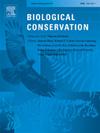Does artificial light interfere with the activity of nocturnal mammals? An experimental study using road underpasses
IF 4.9
1区 环境科学与生态学
Q1 BIODIVERSITY CONSERVATION
引用次数: 0
Abstract
The emission of artificial light at night (ALAN) generates a light pollution. The impacts on fauna, flora and ecosystems have been increasingly studied in recent decades. However, mammals - except bats or rodents - remain under-studied, particularly in terms of space use. Here, we implemented a three-year in-situ before–during–after exposure protocol to assess the effect of artificial light at night at five underpasses of a motorway in a French regional natural park. Using camera traps, we recorded movements of medium-sized wild mammals and collected data on 12 species, especially European badger Meles meles, red fox Vulpes vulpes and martens (Martes martes and M. foina). Our results showed that lighting significantly decreased the probability to cross the underpasses for European badger in spring and autumn and for red fox in spring, while there was no significant effect of lighting for martens. Lighting also reduced crossing speed for badgers. We can conclude that, for some medium-sized wild mammals, ALAN triggers an avoidance behaviour that prevents them from crossing lit underpasses during certain seasons. This suggests that ALAN can act as a nightscape fragmentation, which is in line with previous studies on other taxa - as bats, insects, amphibians or eels. This additional barrier effect confirms the value of dark infrastructure; i.e. ecological network policies to preserve dark habitat patches and dark corridors.
求助全文
约1分钟内获得全文
求助全文
来源期刊

Biological Conservation
环境科学-环境科学
CiteScore
10.20
自引率
3.40%
发文量
295
审稿时长
61 days
期刊介绍:
Biological Conservation is an international leading journal in the discipline of conservation biology. The journal publishes articles spanning a diverse range of fields that contribute to the biological, sociological, and economic dimensions of conservation and natural resource management. The primary aim of Biological Conservation is the publication of high-quality papers that advance the science and practice of conservation, or which demonstrate the application of conservation principles for natural resource management and policy. Therefore it will be of interest to a broad international readership.
 求助内容:
求助内容: 应助结果提醒方式:
应助结果提醒方式:


